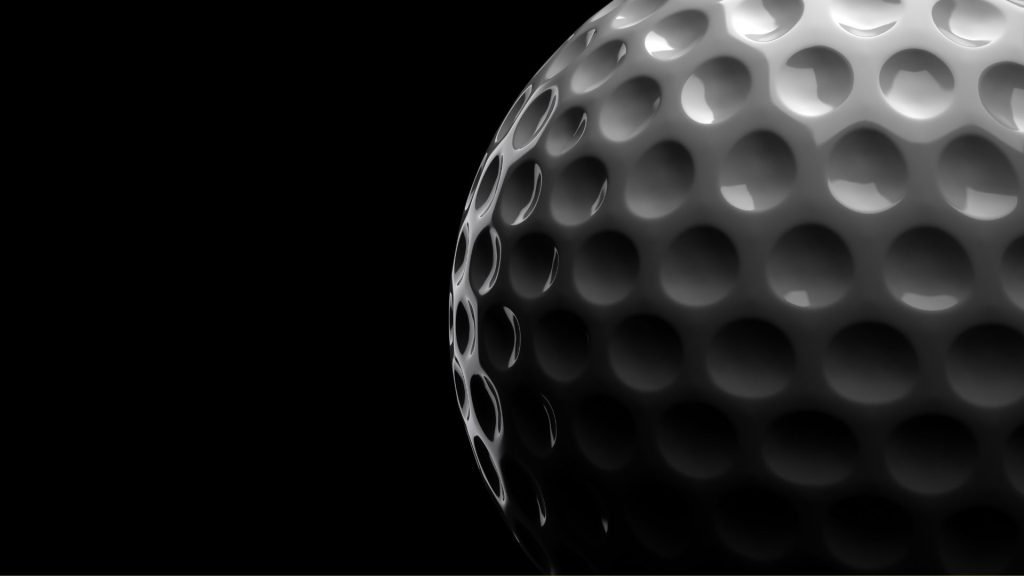
Golf, often dubbed the “gentleman’s game,” is a sport where every detail matters, and even the smallest elements can make a significant impact on performance. One such detail that may seem inconspicuous but wields tremendous influence is the dimples on a golf ball.
In the world of golf, the intricacies of dimple design have a profound effect on how the ball travels through the air, covering the fairways, soaring through the greens, and eventually finding its way into the cup. The relationship between these tiny craters and the game’s outcome is a fascinating journey through the realms of physics, aerodynamics, and engineering.
This article delves into the remarkable world of golf ball dimples, unravelling their secrets and exploring their profound impact on performance. From understanding their basic purpose to delving into the intricate science of aerodynamics and lift, we aim to shed light on why dimples matter in the game of golf. Whether you’re a seasoned golfer looking to fine-tune your game or a beginner eager to grasp the essentials, this exploration of golf ball dimples promises to be both informative and insightful.
So, join us as we embark on a journey to uncover the hidden influence of these seemingly insignificant dimples and discover how they can affect your game on the course. Whether you’re teeing off on the first hole or honing your skills on the putting green, a deeper understanding of dimples could be the key to unlocking your golfing potential.
Also Read: The Science Behind Golf Ball Compression
Table of Contents
The Basics of Golf Ball Dimples
Golf ball dimples are small, often circular depressions covering the surface of a golf ball. These seemingly simple features play a pivotal role in the game of golf, influencing the ball’s flight, distance, accuracy, and more. To understand their significance, it’s essential to delve into the basics of golf ball dimples.
Purpose and Historical Evolution
Golf ball dimples are not mere decorations; they serve a crucial purpose. In the early days of golf, smooth-surfaced balls were the norm. However, golfers quickly noticed that battered, scratched, or otherwise non-smooth balls traveled farther and more accurately than their pristine counterparts.
As a result, golfers began experimenting with various surface irregularities, eventually leading to the incorporation of dimples. Dimples are strategically designed to create turbulence in the boundary layer of air around the ball as it moves through the atmosphere. This turbulence, in turn, reduces drag and enhances lift, making the ball’s flight more predictable and efficient.
The Science Behind Dimples
To grasp the science behind golf ball dimples, consider the concept of aerodynamics. When a golf ball is in motion, it encounters air resistance or drag. Without dimples, the boundary layer of air surrounding the ball becomes laminar, meaning it flows smoothly. In a laminar flow, the air sticks to the surface, creating a high-pressure zone in front of the ball and a low-pressure zone behind it. This results in significant drag, limiting the ball’s flight distance.
Dimples disrupt this laminar flow. They create a turbulent boundary layer of air, which effectively “trips” the flow, making it turbulent rather than smooth. As a result, the low-pressure zone behind the ball is less pronounced, and the ball experiences less drag. Additionally, the turbulent flow creates lift, a critical factor in the ball’s trajectory.
Dimple Design
Golf ball manufacturers invest significant resources in designing and optimizing dimples. Dimple patterns, their size, depth, and distribution are carefully engineered to achieve specific aerodynamic characteristics. Common dimple patterns include icosahedral, octahedral, and tetrahedral arrangements, each with its own aerodynamic effects.
The number and size of dimples can also vary between golf ball models. A typical golf ball has anywhere from 300 to 500 dimples. Smaller dimples may enhance lift, while larger ones can reduce drag, affecting the ball’s performance. It’s essential to note that the specific dimple pattern and design significantly impact a golf ball’s flight, spin, and overall performance.
Also Read: Golf Ball Construction
Aerodynamics and Lift
A fundamental aspect of understanding the impact of golf ball dimples on performance lies in the realm of aerodynamics and the concept of lift. While golfers may not be fluid dynamics experts, a basic grasp of these principles can significantly enhance their appreciation of how dimples influence the trajectory of their shots.
Aerodynamics, in the context of golf, refers to the science of how air interacts with objects in motion, specifically golf balls. Golf balls, when in flight, are subject to the forces of lift and drag. The dimples on a golf ball play a pivotal role in managing these forces.
Dimples create turbulence in the air around the ball as it moves, effectively delaying the separation of airflow from the surface of the ball. This delay reduces drag, which is the force that resists the ball’s forward motion. Reduced drag means the golf ball can travel farther, enhancing its overall distance.
Lift, another critical aerodynamic principle, contributes to the golf ball’s ability to stay aloft. The interaction of dimples with airflow generates lift, ensuring that the ball follows a more stable and prolonged trajectory, aiding in its flight accuracy. Thus, the dimples’ arrangement and design have a direct impact on both the distance a golf ball can travel and its ability to maintain a predictable course.
The Impact on Distance
One of the most significant effects of golf ball dimples is on the distance the ball can travel. The science of dimples and distance is fascinating. In essence, the dimples allow the ball to stay in the air for a longer period, leading to greater distance.
Different dimple designs and patterns can significantly impact the distance a golf ball can achieve. For instance, some golf balls have dimples that are shallower, while others have deeper, larger dimples. The specific design influences the balance between lift and drag, directly affecting the ball’s flight.
Accuracy and Control
The influence of golf ball dimples on accuracy and control is a critical aspect of the game that often goes unnoticed. Dimples play a significant role in shaping a golfer’s ability to hit precise shots and control the direction of the ball.
Golf ball dimples work by reducing drag and optimizing the lift generated by the ball. This aerodynamic effect, while essential for distance, also affects the ball’s stability during flight. When the ball is in the air, dimples create a thin turbulent boundary layer of air that helps the ball maintain a stable trajectory. This stability translates to greater accuracy, as it minimizes the erratic swaying or wobbling that a smooth-surfaced ball might experience.
Furthermore, dimple patterns and their arrangement impact shot control. Golfers can use specific dimple designs to their advantage, depending on their playing style and environmental conditions. Some dimple patterns may help golfers control the ball’s flight path better, particularly in windy conditions.
Golfers who prioritize accuracy and control should pay close attention to the dimple configuration of the balls they choose. Selecting a golf ball with dimples that align with your playing style can lead to improved shot placement, making those crucial approach shots and putts more predictable and precise. In essence, understanding the interplay between dimples and accuracy can be a game-changer for golfers aiming to lower their scores.
Also Read: The Role of Golf Ball Cover Materials in Shot Control
Greenside Spin and Feel
The texture of the golf ball’s surface, largely due to the dimples, affects greenside performance. Golfers need to control the ball’s spin when they’re on the green, particularly during chipping and putting. The dimples play a pivotal role in this aspect.
The interaction between the dimples and the clubface helps determine how much spin is imparted to the ball during these short shots. Additionally, the feel of the ball as it contacts the putter or wedge face is influenced by the dimple pattern, affecting a player’s control during these critical moments.
Golf Ball Brands and Dimple Designs
Golf ball manufacturers understand the intricate relationship between dimples and performance, and they invest heavily in research and development to create innovative dimple designs. Every major golf ball brand, including Titleist, Callaway, TaylorMade, and others, has its unique dimple patterns.
Titleist, for instance, is known for its Pro V1 golf balls with a 352-dimple pattern that offers excellent control and feel. Callaway’s Chrome Soft features a different hexagonal dimple design that promotes distance and accuracy. It’s important to explore these different dimple designs to find a ball that suits your playing style.
Choosing the Right Golf Ball
With an understanding of how dimples affect golf ball performance, it’s essential to choose the right golf ball for your game. The perfect ball depends on factors such as your swing speed, playing conditions, and personal preferences.
- Swing Speed: Faster swing speeds benefit from golf balls with different dimple patterns compared to slower swing speeds. Dimples impact the launch angle and spin rates, which are essential for maximizing your distance and accuracy.
- Playing Conditions: Consider whether you primarily play in windy conditions, high altitudes, or on wet greens. The right dimple pattern can mitigate the challenges presented by these conditions.
- Personal Preferences: Some golfers prefer softer feel and more spin, while others prioritize distance and control. Knowing your preferences can help you find the right ball.
Conclusion
In conclusion, golf ball dimples may appear insignificant at first glance, but they are integral to a golfer’s performance. They influence the ball’s aerodynamics, lift, distance, accuracy, control, and greenside performance. Understanding the science behind dimples can lead to improved decision-making when selecting the right golf ball for your game.
As you strive to improve your golfing skills, remember that every detail counts, even the small dimples on your golf ball. So, the next time you tee up, you’ll have a newfound appreciation for those little dimples and how they contribute to your success on the course.
